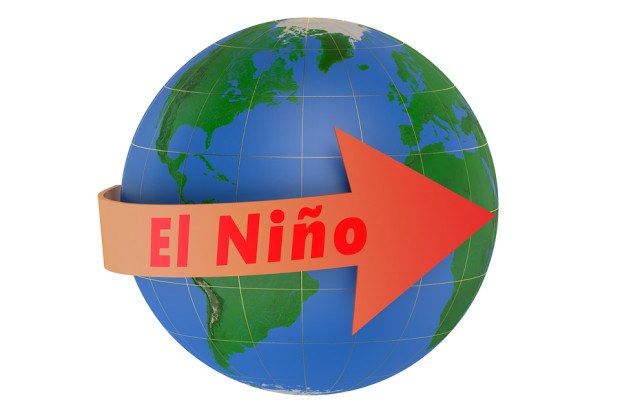The choking haze that has blown across Southeast Asia from burning rain forests in Indonesia may get worse and last several more weeks as an unusually strong El Nino keeps away seasonal rain that would quench the fires.
An intensifying El Nino will probably push back the start of the eastern monsoon until late October or early November, said Robert Field, an associate research scientist at the NASA Goddard Institute for Space Studies at New York’s Columbia University. Heavy rain will be the biggest help in clearing the atmosphere and extinguishing illegally-lit fires on the islands of Sumatra, Borneo and New Guinea.
“Barring a major turnaround in fire-fighting and prevention, burning will continue until the start of the wet season in southern Sumatra and southern Kalimantan” on Borneo, Field said in an e-mail.
Indonesia has enlisted help from its neighbors to fight the fires, with Malaysia and Singapore sending aircraft to carry out water bombing in Sumatra, the country’s disaster agency said on Oct. 10.
The last big El Nino was in 1997, when at least 40,000 fires in Indonesia destroyed an area the size of Costa Rica and released an estimated 1 gigaton of carbon into the atmosphere — the equivalent of more than 10 percent of the world’s annual fossil fuel emissions at the time.
1997 Crisis
As the El Nino brewed, and the region descended into a financial crisis, the lung-clogging smoke remained over Indonesia and neighboring countries like Singapore and Malaysia for three months, hurting the health, property and livelihoods of 75 million people, and causing more than 16,400 infant and fetal deaths.
This year, about 125,000 people have suffered haze-linked ailments, Indonesia’s disaster relief agency said this month. A pollution index reached 1,990 in Palangkaraya in central Kalimantan at the end of September, more than five times the level considered hazardous, according to the country’s Meteorology, Climatology and Geophysics Agency.
“The main challenge, El Nino, is quite severe, exceeding 1997-1998,” said Luhut Panjaitan, Indonesia’s coordinating minister for law and security. “The dry season is worse and that makes it difficult to extinguish the fires.”
While the smoke largely dispersed over Singapore and parts of Malaysia last week, the respite may be brief. Malaysia’s Department of Environment counted 10 districts out of 52 on Monday afternoon where air quality was “good,” down from 12 on Friday afternoon. Singapore’s 24-hour air quality index rose into the “unhealthy” range yesterday for the first time in five days.
Burning Peat
“If the burning continues through October and November, emissions from biomass burning — mostly drained peatlands– could rank among the highest on record for Indonesia,” said Allan Spessa, a research fellow in the department of environment, earth and ecosystems at the Open University in Milton Keynes, England.
The fires in Indonesia, which are mostly lit to clear land, are extremely difficult to extinguish because of peat below the soil surface, which burns like coal and can smolder for months. Borneo’s peat reserves store the equivalent of about nine years’ worth of global fossil fuel emissions.
Twelve companies and 209 individuals are suspected of causing the blazes, with a Singaporean company also under investigation, Badrodin Haiti, Indonesia’s chief of police, told reporters in Jakarta on Monday. Haiti didn’t name the companies.
Out-emitting Germany
Fires on Sumatra blackened 1,400 square kilometers in a single week in June, an area the size of Long Island in New York. Across the archipelago, they have released more greenhouse gases than the amount of carbon dioxide Germany emits in a year, according to Guido van der Werf, a scientist tracking forest fires and carbon emissions at VU University in Amsterdam.
“And we are only halfway through the fire season,” he said in a report last month.
Scientists predict this El Nino, a global weather phenomenon characterized by a warming of the ocean surface in the equatorial Pacific, will rank among the most severe since at least the mid-20th century, and set a record in 2015 for the hottest global temperature.
Related News and Information: Singapore, Malaysia Fly in Planes to Fight Indonesia’s Haze (1) World’s Oldest Rainforests Burn as Jokowi Scales Back Promises Indonesia to Accept Help From Other Nations as Haze Intensifies Today’s Top Stories Worldwide: TOPWW Today’s Most-read Environment Stories: MNI ENV
–With assistance from Rieka Rahadiana in Jakarta.





















 California Workers Comp Combined Ratio for 2024 Highest in 20-Plus Years
California Workers Comp Combined Ratio for 2024 Highest in 20-Plus Years  Northern California Flooding This Weekend Caused by Heavy Rain, High Tides
Northern California Flooding This Weekend Caused by Heavy Rain, High Tides  Breaking: Andersen to Replace Zaffino as CEO of AIG on June 1
Breaking: Andersen to Replace Zaffino as CEO of AIG on June 1  Underwriter, Actuary Fears of AI Drop; Work Needed on Collaboration
Underwriter, Actuary Fears of AI Drop; Work Needed on Collaboration 



